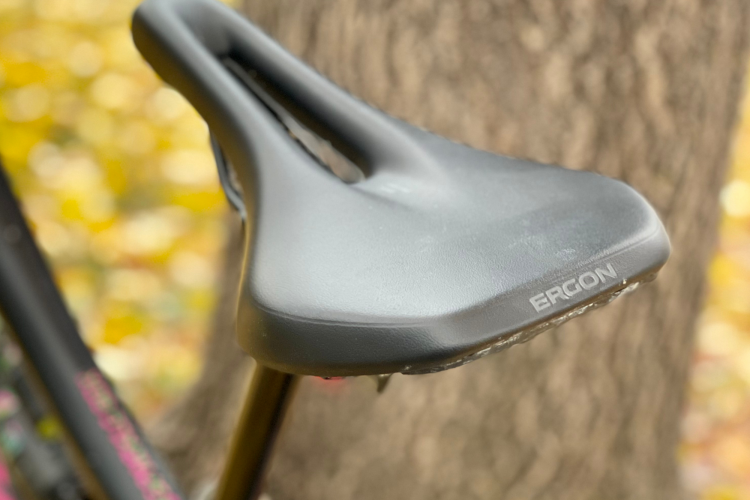
Bikes and derailleurs are electric now, so why not saddles too? Just kidding. The Reform Tantalus isn’t an electric saddle, but it does use technology in a bid to improve saddle fit and comfort. I tested the Reform Tantalus on a couple of different mountain bikes to see how it works, and also let a friend borrow it to get a second opinion.
Reform Tantalus saddle specs
- Size: 254x142mm
- Titanium rails and carbon/nylon base
- Weight: 266.3g
- Price: $300 USD (get $50 back if you return the AC unit)
- Buy from Reform Saddle
Reform saddles feature a patented design that uses heat to mold the saddle to each rider’s unique shape. Heat molding has been used for cycling shoes and even grips for some time, and as a third contact point on the bike, it makes sense that saddles can benefit from the concept too. A heating element is integrated into the shell, and when connected to the included AC unit, it heats the padding and shell, making it malleable. Once cooled, everything retains its custom shape.


Compared to custom, 3D-printed saddles, the Reform Tantalus is generally easier to set up and doesn’t require sending off a mold or a scan of your butt. It’s also less expensive than most of the 3D-printed custom saddles on the market.
Before molding the Tantalus, I went for a couple rides with the saddle right out of the box to see how it felt and to compare before and after. The padding is definitely on the firm side, and similar to more race-oriented saddles. In its default, unmolded state, it wasn’t uncomfortable necessarily, but also not as comfortable as my Ergon SMC Core with Infinergy® foam padding.
I went through the molding process twice and found it’s quick and easy, though the provided instructions are more geared toward road biking than mountain biking. After heating the saddle for about five minutes, BC-based Reform recommends riding for 10 minutes and changing saddle position once every 30 seconds. I found that a trail ride isn’t very effective, especially if you’re out of the saddle a lot or bouncing around technical terrain. My friend Chase, who also tested the saddle, set his up on an indoor trainer first, which seemed to work out better. Riding your mountain bike on the road should also do the trick.
After molding, I couldn’t see any visible changes in the saddle, though Chase says he was able to see indentations from his mold. This could be due to our differing setup methods, or possibly a difference in sit bone widths. Reform says the saddle is optimized for riders with a 135-150mm sit bone width, and mine are just 114mm apart. Away from the center of the saddle, it’s likely the shell and padding are able to flex more. “In addition to the impressions left by sit bones, it is normal for the widest points of the saddle to fold down up to 5mm during forming to create pressure relief,” according to a FAQ on the brand’s website.


Reform recommends a temperature range for the saddle between -5°C and 40°C (23°F and 104°F). Presumably at the high end of the range, the padding could lose its shape and need to be molded again. I suspect even leaving the black saddle sitting in direct sun could have a similar effect. The upshot is if it gets too hot, the saddle can be remolded in short order.
The integrated heating element is thin, and doesn’t seem to add notable weight to the saddle; at 266g, this mountain bike saddle is solidly mid-weight. The titanium rails and carbon/nylon frame surely help keep the weight down, and also add to the saddle’s vibration damping capabilities.
I’m not very picky when it comes to mountain bike saddles, so I wanted to hear what Chase thought about the Reform Tantalus. It’s “firmer than expected, but after 150 miles it never bothered me,” he said. Chase had trouble mounting the saddle as far forward as the one he replaced, perhaps due to a difference in the length or configuration of the Tantalus rails. Given the firm feel, both of us decided the saddle might benefit from a more flexible layer of padding on top of the moldable material for the best of both worlds, particularly toward the nose of the saddle.
Pros and cons of the Reform Tantalus custom moldable off-road saddle
Pros
- Easy to set up
- Custom shape reduces pressure points
- Reasonable price and weight
Cons
- Only one width, so riders with narrow sit bones may not fully benefit
- Padding may be too firm for some
Bottom line
The Reform Tantalus is a solid, high-quality off-road saddle that could be the solution to your saddle sores thanks to its customizable shape.




















0 Comments